IDEX Online Research: US Jewelry Sales Up Just 2.3% in March
June 01, 14
Jewelry and watch sales in the U.S. increased by 2.3 percent on the year in March to $5.63 billion, based on preliminary US government figures.
The larger story, however, concerns the major revisions downwards in the figures for January and February to 2.8 percent and 2.3 percent, respectively from the previous official statistics showing increases of 3.6 percent and 6.4 percent.
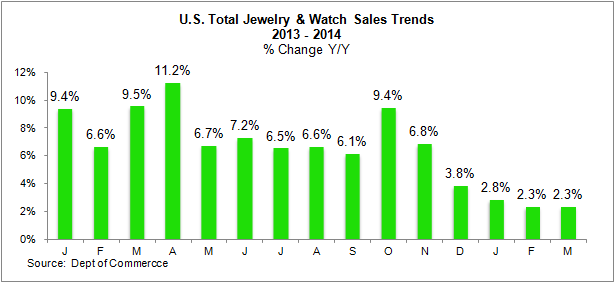
The increase in March was, therefore, in line with the figures for the first two months of this year, but the decline from last year, particularly from October is extremely marked and illustrates strongly the softness of jewelry sales.
US jewelry retailers’ sales hardly moved in March, rising by just 0.1 percent on the year-earlier figure to $2.38 billion – down almost $600 million on the February figure of $2.91 billion. Sales in the first three months of this year came to $7.34 billion – a rise of close to 5 percent on the same quarter of 2013.
The changes in percentage terms in overall jewelry and watch sales can be seen in this graph.
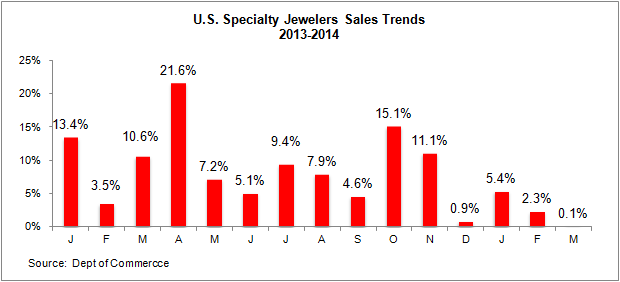
There was a significant decline on the month in sales at specialty jewelers in March compared with the figures for total jewelry sales for the month as can be seen in the following graph, with total jewelry sales crushing the performance of the specialty jewelers.
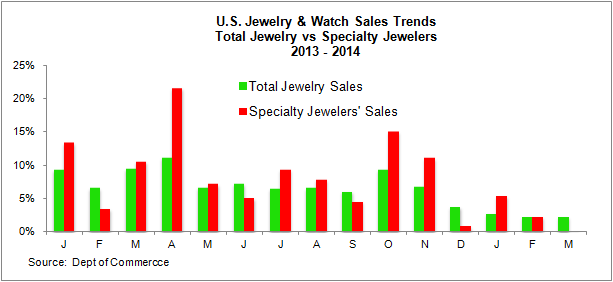
Consumers were again voting with their feet and buying goods at general jewelry stores and other shops selling jewelry along with other goods. That is likely due to deep discounts offered by general stores in a bid to attract custom while specialty jewelers tried to hold the line and keep prices at a level that would ensure better profitability.
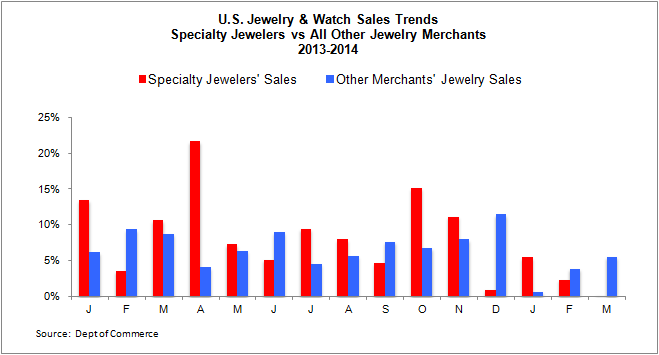
Total Jewelry Sales +2.2%
Jewelry sales alone, excluding watches, increased by 2.2 percent on the year in February to $2.38 billion, based on US Department of Commerce data.
Fine Watch Sales +2.4%
Fine watch sales rose by 2.4 percent in March to $450 million.
Fine watch sales have kept their proportion in the broader jewelry and fine watch sales category at around 12 percent as is clear in the following graph.
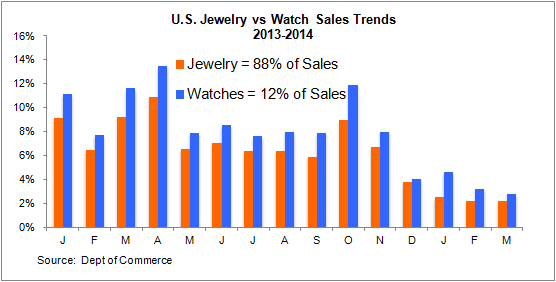
This mix of watch sales is climbing, after falling to 11.6 percent of sales in 2010, as the industry was still reeling from the impact of the “Great Recession” that began in 2007.
In 2006, just prior to the recession, fine watch sales represented 12.1 percent of total fine jewelry and watch sales in the U.S. However, during the recession, consumers tightened their purse strings, and slowed their buying of expensive, flashy watches.
Jewelry & Watch Spending
As has been seen during the past 15 months, rises in retail jewelry and watch sales are better than those for retail sales in general, and that was again seen strongly in March.
While retail sales overall by a negligible amount in March, jewelry sales were up by more than 2 percent.
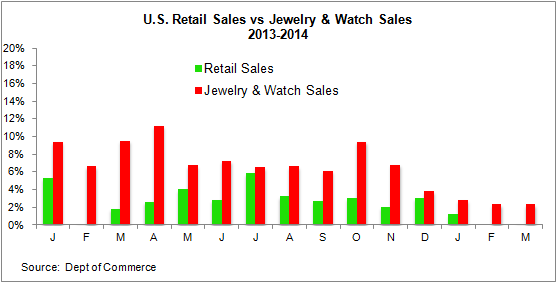
Annual consumer purchases of jewelry and watches, however, is only just over $70 billion. When placed next to overall annual retail sales of $11 trillion, the relative insignificance of the figure becomes clear.
Outlook
With jewelry sales up only slightly more than 2 percent in the United States in March, the traditional American love affair with jewelry appears to be diminishing.
Some analysts said the decline in spending in March was due to higher healthcare costs and enrolment in Obamacare, as well as higher utilities costs after a harsh winter forced households to use more gas and electricity.